
Monday, August 17, 2009
Processed Food Bad
What to do from a policy standpoint about processed food. Let's review what we mean by processed food, i.e. why is it different than traditional methods of making food.
Monday, June 8, 2009
Snap, son! Baseballer Ryan Howard gets White House garden tour | Grist
seriously, we have baseball players at the whitehouse talking about organic food and how awesome it is!? crazy times
Wednesday, April 29, 2009
Arugula - wild seeding edition
No, I'm not going to stop talking about arugula. so just deal with it.

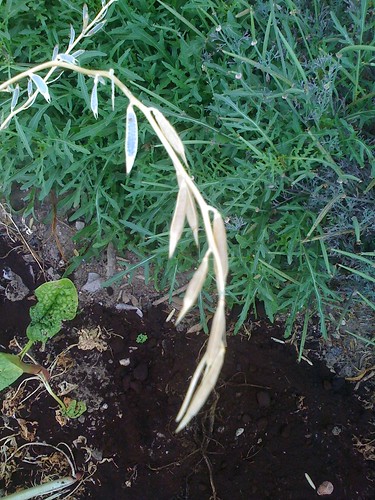
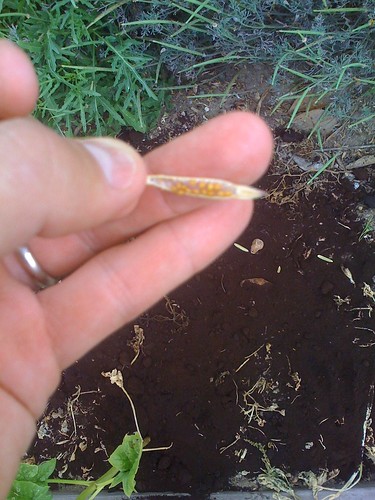



potatoes again, maybe
So my last attempt at potatoes failed (pretty badly it turns out) due to some pest, I think pill bugs, so I think that I am inspired by this to try again. It involves building things, so that's good. It is a great example of intensive gardening, so that's good. I will employ some methods to keep pill bugs at bay, organically of course, so that's good too.


Thursday, April 23, 2009
White House Garden Quiz
I am obviously a little obsessed with the garden. But not obsessed enough!! i only got an 86% on an online quiz about it!!!!

See well how you can do.

See well how you can do.
Rhubarb
So yet another vegetable that I wouldn't know much about without home gardens. I vaguely remember my mom growing some and then a friend made some great rhubarb cobbler when I was in graduate school in Georgia. Then some other vague times to have some here and there, but now it is time for me to have some of my own. I planted some seeds in a cup on the window sill. ~6 weeks later, here we are:
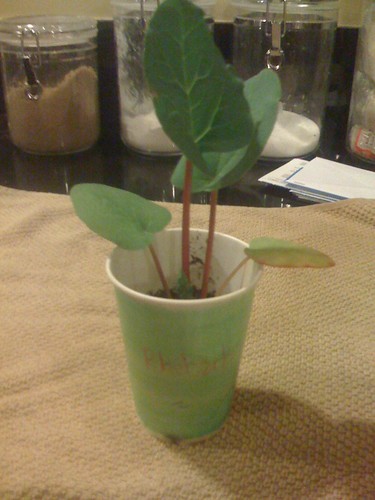
You know what probably goes great with Rhubarb in a cobbler? Blackberries (just blossoms for now).

You know what probably goes great with Rhubarb in a cobbler? Blackberries (just blossoms for now).
Wednesday, April 22, 2009
5 minutes 13 seconds
That's how long it took me to plant a new bed of lettuce greens. Let me show you, because, we all are pressed for time. Especially those of us with 3 kids.
I did this after putting the baby to sleep, before I put the big kids down. They were brushing their teeth.
1. walk to garage to get a handful of bonemeal.
2. walk to veggie bed and level a 2'x2' patch of soil that had been previously cleared. take picture.
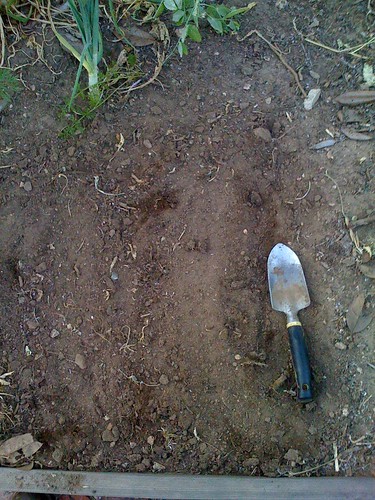
3. dump a pile of coffee grounds from Starbucks and throw bonemeal on top. take picture.
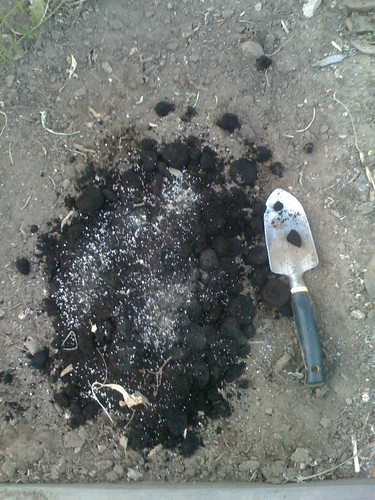
4. spread these over patch and slightly, barely mix in with soil. take picture.
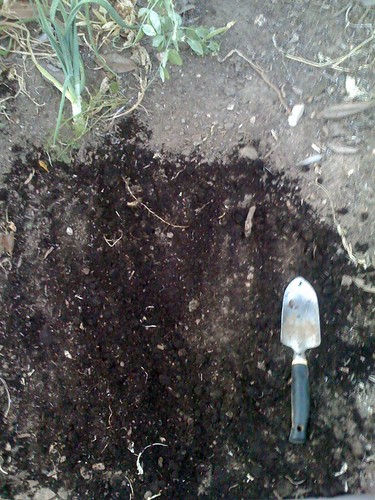
5. scatter mesclun mix seeds evenly on patch. take picture.

6. lightly cover with loose soil. take picture.

7. done.
Lettuce is easy. Plant lots of it. Don't forget arugula. This was actually supposed to be arugula, but at the last minute, I couldn't find my seeds, and I only had 5 minutes and 13 seconds!
I did this after putting the baby to sleep, before I put the big kids down. They were brushing their teeth.
1. walk to garage to get a handful of bonemeal.
2. walk to veggie bed and level a 2'x2' patch of soil that had been previously cleared. take picture.

3. dump a pile of coffee grounds from Starbucks and throw bonemeal on top. take picture.

4. spread these over patch and slightly, barely mix in with soil. take picture.

5. scatter mesclun mix seeds evenly on patch. take picture.

6. lightly cover with loose soil. take picture.

7. done.
Lettuce is easy. Plant lots of it. Don't forget arugula. This was actually supposed to be arugula, but at the last minute, I couldn't find my seeds, and I only had 5 minutes and 13 seconds!
Monday, April 20, 2009
Ask FYV - Preparing the Soil
"Take care of your soil, and your soil will take care of you"
-some smart guy
For maximum growth of your vegetables, you must have loose, nutrient-rich soil. Here is why:

Look at that picture and you see the roots of a carrot going down up to 7 feet down. As I will show below, that only happens when your soil is well cared for.
I am clearly no Michael Pollan, but let me attempt to boil down my rules for soil into their bare essentials.
loosen soil. add organic material. cover well. stay off.
That really is it, but I will explain a bit. Let me also note, that if the thought of doing anything to your soil is overwhelming for your first time growing anything, then don't. I give you permission to make holes in the ground and put the seeds/plants in them and do nothing else.
soil structure - if you look at this picture, you can see the difference between loosened soil and compacted soil on the root structure.

Today I will cover just one aspect:
loosen soil
I do the following ONCE (as in ever) when I prepare a vegetable bed. I mark out the area that I will be planting in, and start digging down ~1-2 feet and move all that dirt to the side. Then I use a pitchfork and seriously loosen the soil a further 2 feet. I throw in as much organic material as I can, then replace the top layer of soil and mix. I then cover it with a couple of inches of (non-woody) mulch
That is a good bit of work and you don't have to do it. In between nothing and what I do, you can simply cover the ground with lots of good compost, coffee grounds, mulch whatever. Add some organic fertilizers and you are set. if there is organic material there, then earthworms will do the rest over time. If you really want to understand this approach then I recommend "lasagna gardening" The entire book is summarized in the first 10 pages or so.
I will delve into more details on what to add to your soil next.
bad day for planting
So I went and bought a few plants for the garden (eggplant, melon, zuchinni, more basil), and THEN I looked at the forcast. (this is the printout from the next day, you still get the idea)

Sunday turned out to be 97, today ~100. I will wait until Wednesday to plant those babies...

Sunday turned out to be 97, today ~100. I will wait until Wednesday to plant those babies...
Wednesday, April 15, 2009
Tuesday, April 14, 2009
the boy likes fresh strawberries
and he knows that they are in the front lawn. He don't need no stinkin' clothes to go get them.


Monday, April 13, 2009
great new blog (to me that is)
So, if you are one of the many (many!!) people who read my blog AND People magazine, then you will already know about the blog, theslowcook.com, but in case you are not, then I highly recommend his stuff. It is great. I will just point you to a single quick post about the blooming peach tree at his daughter's school. It reminds me of my peach tree right now and the apricot tree that is now weighed down with over 100 apricots!!!! OH YEAH!
Anyway, check out his blog.
Anyway, check out his blog.
Carrots and lunch
Well, yesterday was a fantastic Easter, and in the midst of the clean-up and gearing up for the upcoming week, I came across a sprouting onion in our kitchen that my mom had given us in case we could use it. I thought, well now is the time to use it for something. I realized I could use it a bag of lentil soup mix that also came from her. (I think!) Along with a frozen ham bone from some holiday meal a while back. I needed carrots and remembered that I had a whole patch of them out front!!! I threw in some of the last of the shallots and voila, I had a cheap, garden-filled meal that will work for at least a couple lunches, is super healthy and cost me nearly nothing:

Here is the soup at lunch today. Yuuhhuummm!

So this is something of a milestone for me, though it sounds absurd. This might be the first time that I have cooked with mine own carrots. So, whooppee! Usually I just eat them straight from the ground. These ones were good fresh as well, though maybe a little overgrown.

Here is the soup at lunch today. Yuuhhuummm!

So this is something of a milestone for me, though it sounds absurd. This might be the first time that I have cooked with mine own carrots. So, whooppee! Usually I just eat them straight from the ground. These ones were good fresh as well, though maybe a little overgrown.
Friday, April 10, 2009
White House Garden Update Update

Yes, they did have the planting day, and it was with the same kids who helped dig up the patch of lawn a couple weeks ago. Apparently, they will have them return yet again and cook some of the food and eat it together. That is cool. A few notes:
- The emphasis that Michelle is putting on the symbolism of the kids' participation is simply fantastic along with the connection to eating the food they grow.
- Tom Vilsack, the Secretary of Agriculture, was present for the planting. That is really a big deal, because the Dept. of Ag. has largely been focused on the politics of food growers, whereas his presence at this event emphasizes the politics of food consumers.
I love this last little picture, because it captures what I have striven for in my garden and the garden at my daughter's elementary school. Grow things that are visceral: good taste, good smell and visually appealing, because that is what gets embedded in a kid's mind and becomes the memory and guidepost for the adult in later years.
- Uh, it is nice to see Mrs. Obama wearing something more akin to grubby clothes for the gardening. Turning over the sod in her black dress last time was just not right.
Thursday, April 9, 2009
White House Gardening Update
Apparently, today is the day! I will update as I find out anything!
Thursday, April 9: The First Lady will host an event in the White House Kitchen Garden on the South Lawn of the White House to plant the garden. She will be joined by Agriculture Secretary Tom Vilsack and students from Bancroft Elementary, the school that participated in the groundbreaking of the Garden on March 20th. Students from the school will return later this year for harvesting and cooking with the food grown.
Tuesday, April 7, 2009
Ask FYV - Pests: Pill Bugs

A friend writes:
do you think Pill Bugs are bad for the garden. I have quite a few; found this snippet on internet and wondered if you agreed:
Pill bugs (or roly poly's as I have always called them) feed primarily on decaying matter. I have observed them in my garden for long periods of time, and done a little research, just to figure out what they are doing (I obviously have no life (but am afterall, a geeky scientist)). In my garden, they are certainly prolific, but appear to chow down on the remnants of my compost pile that hadn't completely broken down. These observations have put my mind at rest, and confirmed that these crustaceans are actually beneficial to the health of my garden. However, I might also point out that my small garden consists only of peppers, corn, cucumbers, tomatoes, and lettuce--that is to say, they may have an appetite for other plant varieties and thus could potentially wipe out a garden of other plant species (although I think this is rare and unlikely). Most crustaceans in this world (be them terrestrial or aquatic) are primarily scavengers--they are the "garbage men" of the microcosmic insect world. They eat fungus, molds, and other dead things and play a beneficial role in the cycle of nutrients. If you have vegetative plants that are dying, it is likely the cause of some other perpetrator--likely one that you cannot see with the bare eye. Roly-poly's in your garden, in my opinion, are a sign of a healthy nutrient exchange. Look in to other likely pests such as aphids, parasites, or even vegetative diseases.
So, I did a lot of research about this a few years back as I was having a terrible time with "something" eating lots of my seedlings in particular. I turned to the gardenweb.com forums about pests and (this sounds ridiculous) there was a RAGING argument about pill bugs, with people in both camps either that they only chew up dead/dying leaves and others (including me) insisting that they were killing live plants, particularly seedlings. Someone finally noticed that everyone that claimed pill bugs killed live plants lived in a southern state, particularly CA & Texas. It seems that in the warm climates, especially with heavily mulched beds, the populations become very large and voracious without a strong winter chill to knock back the population. I personally observed one night with a flashlight an entire 4'x4' planting of bean seedlings that were just beginning to germinate get eviscerated. Basically every seedling that was beginning to unfurl was covered in a few pill bugs each. Also I had a young, tender basil plant get stripped in a single night. They seem to also destroy my potato leaves. The best organic solutions are either submerged cups of beer (usually a slug remedy) which get filled with pill bugs on a nightly basis where they drown. Also large dustings of diatomaceous earth seem to work. I am pretty sure that this worked, though it is harder to tell. I am just now having a lot of problems again, so this is a good reminder to set things up again.
So there you have it, if you live in a part of the country with a real winter, don't worry too much. If you live in a glorious part of the country with no freezing winter, watch out!
What I would really like is to put some chickens in the beds for a couple days to decimate the populations.
Thursday, April 2, 2009
yeah, still want to be a farmer someday
things like this don't help the itch. cool website too.
[youtube=http://www.youtube.com/watch?v=zH7o3fxw6oE&feature=player_embedded]
[youtube=http://www.youtube.com/watch?v=zH7o3fxw6oE&feature=player_embedded]
organic oreos - still bad for you - but better for farmers!
I was alerted to the existence of these:

by this post at the internet food association. It raises, especially in the comments the entire issue of the "paradox" of organic junk food.
Michael Pollan has discussed this at length as well, using hypothetical "organic Coke" as an example. He concludes that there will be positives and negatives. Likewise, I think that at one level, organic oreos are great! A ll those wheat and corn fields that will no longer have nitrogen and pesticide runoff really do translate into improvements for farmworkers and ecosystems. They will still be unhealthy as ever except perhaps the absence of some barely detectable levels of residual pesticides. And they are still bad for your health. However, it's not as though organic Oreos are going to spark a sudden increase in the amount of junk food eaten.
I think the problem is that ultimately organic is a word that we think means "wholesome and good for the consumer", when in reality it is a word that refers to a relatively dry list of technical regulations about how various foods must be grown. These regs have some implications for health of consumers, but in reality they have much more to do with the impacts of agriculture on those who do the growing.
Healthy eating really is largely a distinct issue from sustainable agriculture. People who care about the latter almost certainly care about the former, but the reverse is much less true. A lot of confusion comes from that relationship.

by this post at the internet food association. It raises, especially in the comments the entire issue of the "paradox" of organic junk food.
Michael Pollan has discussed this at length as well, using hypothetical "organic Coke" as an example. He concludes that there will be positives and negatives. Likewise, I think that at one level, organic oreos are great! A ll those wheat and corn fields that will no longer have nitrogen and pesticide runoff really do translate into improvements for farmworkers and ecosystems. They will still be unhealthy as ever except perhaps the absence of some barely detectable levels of residual pesticides. And they are still bad for your health. However, it's not as though organic Oreos are going to spark a sudden increase in the amount of junk food eaten.
I think the problem is that ultimately organic is a word that we think means "wholesome and good for the consumer", when in reality it is a word that refers to a relatively dry list of technical regulations about how various foods must be grown. These regs have some implications for health of consumers, but in reality they have much more to do with the impacts of agriculture on those who do the growing.
Healthy eating really is largely a distinct issue from sustainable agriculture. People who care about the latter almost certainly care about the former, but the reverse is much less true. A lot of confusion comes from that relationship.
Thursday, March 26, 2009
Eat *less* Red Meat
A new study shows a pretty startling correlation between eating red meat and dying!
Apparently eating ~1/4 lb of red meat per day increased the chances of dying by 30% over the course of the 10 years of the study. My wife and I got to talking about this, and we realized that we have gotten to the point where we are only eating red meat 2-4 times a month at most. That was a conscious shift over a number of years to some degree, but it actually shocked me that we eat so little when I counted it up, so clearly it has become completely unconscious. Other than In-n-Out, and an occasional steak, there is not a lot of red meat that I am dying to have. We just don't think about it much, so yeah for us.
Of course there are a tremendous number of environmental reasons to not eat meat to consider.
Lastly, for those of you who want to know whether it is all the fats, methods of preparation, or whatnot that makes red meat unhealthy, read this book.
P.S. Chicken and Fish are just fine to eat!
Apparently eating ~1/4 lb of red meat per day increased the chances of dying by 30% over the course of the 10 years of the study. My wife and I got to talking about this, and we realized that we have gotten to the point where we are only eating red meat 2-4 times a month at most. That was a conscious shift over a number of years to some degree, but it actually shocked me that we eat so little when I counted it up, so clearly it has become completely unconscious. Other than In-n-Out, and an occasional steak, there is not a lot of red meat that I am dying to have. We just don't think about it much, so yeah for us.
Of course there are a tremendous number of environmental reasons to not eat meat to consider.
Lastly, for those of you who want to know whether it is all the fats, methods of preparation, or whatnot that makes red meat unhealthy, read this book.
P.S. Chicken and Fish are just fine to eat!
Tuesday, March 24, 2009
notes on White House Veggie Garden Layout
I think that it is instructive to look at what the layout of the WHVG (White House Veggie Garden) tells us about how it will be used. This is probably interesting from a political standpoint, but I am much more interested in it from a kitchen gardener's standpoint. Here is the layout as provided to the NY Times

As you can see, they are planting just a few types of veggies:
lettuces
spinach
chard, kale & collards
snap peas/shell peas
herbs
shallots & onions
fennel
rhubarb, radishes & carrots
Interestingly, the "tender greens", lettuce and spinach compose like 50% of the planting with another 20% given to "hard" greens like chard, kale and collards. Interesting for two reasons. First, if you have read "In Defense of Food" as you should have, you will know that eating greens is one of the most healthy things that you can do for your diet. Second, fresh lettuce and arugula has been an absolute revelation to me about why one should have a kitchen garden. With a relatively small amount of attention, one can grow lettuce that is absolutely far and away superior to anything that you can buy. I will post shortly on how I like growing lettuces. The short version is that scattering seeds for baby lettuce is much easier and tastier than growing lettuce to full head maturity, especially in drier climates like So. Cal.
Lots of fresh peas as well, and certainly I find that snap peas are a favorite of mine and my kids in the garden. It provides a quick, sweet, clean vegetable flavor that I can enjoy anytime I go out there. I think of it as the "gateway" vegetable for kids. It doesn't need to be washed and it is so darn sweet.
Lastly, there is quite a large section reserved for fennel and for herbs. I can't say a lot about fennel, so I won't. But as I have made clear before, havning an abundant supply of fresh herbs is the first thing that anyone who wants to improve the flavor of their cooking should do, hands down.
So, I think that the emphasis on soft greens, peas and herbs reflects the thinking of someone who really knows what a kitchen garden is really good at providing.

As you can see, they are planting just a few types of veggies:
lettuces
spinach
chard, kale & collards
snap peas/shell peas
herbs
shallots & onions
fennel
rhubarb, radishes & carrots
Interestingly, the "tender greens", lettuce and spinach compose like 50% of the planting with another 20% given to "hard" greens like chard, kale and collards. Interesting for two reasons. First, if you have read "In Defense of Food" as you should have, you will know that eating greens is one of the most healthy things that you can do for your diet. Second, fresh lettuce and arugula has been an absolute revelation to me about why one should have a kitchen garden. With a relatively small amount of attention, one can grow lettuce that is absolutely far and away superior to anything that you can buy. I will post shortly on how I like growing lettuces. The short version is that scattering seeds for baby lettuce is much easier and tastier than growing lettuce to full head maturity, especially in drier climates like So. Cal.
Lots of fresh peas as well, and certainly I find that snap peas are a favorite of mine and my kids in the garden. It provides a quick, sweet, clean vegetable flavor that I can enjoy anytime I go out there. I think of it as the "gateway" vegetable for kids. It doesn't need to be washed and it is so darn sweet.
Lastly, there is quite a large section reserved for fennel and for herbs. I can't say a lot about fennel, so I won't. But as I have made clear before, havning an abundant supply of fresh herbs is the first thing that anyone who wants to improve the flavor of their cooking should do, hands down.
So, I think that the emphasis on soft greens, peas and herbs reflects the thinking of someone who really knows what a kitchen garden is really good at providing.
Friday, March 20, 2009
Ask FYG - First Time Gardener Edition
I was thinking about writing a couple ideas for first time gardeners, when a friend of mine thinking of getting started on a veggie garden this year sent out a Facebook SOS. She had gone to a gardening class and became completely overwhelmed as the lecture devolved into details about testing pH levels in her soil (a reasonable thing) and watching for the waxing and waning of the moon (umm... a little less reasonable for first timers, though I find myself curious about it...)
I think that her friend actually posted the best advice of all so I will (without permission) reprint it here:
So true. But let me expound on this a bit. To make it my own, if nothing else.
[caption id="" align="alignnone" width="300" caption="oh, how I wish I had space like that"] [/caption]
[/caption]
First, I would start by figuring out what do you really want out of this first experience. Let me just tell you what you want. You want some stuff that you can eat and that tastes good to grow out of the ground. Now you might think that what you want is: corn, tomatoes, carrots, beans, cucumbers, melons, peas, lettuce, zucchini, squash, pumpkins, a scarecrow, etc. You might dream about constant meals out of the garden all summer long. I would say keep your expectations and planning simple this first time around and stick with the plants that are easy to maintain, and easy to harvest.
So, I am going to make a prioritized list of what you should grow based on my own personal experience with bang/buck
tomatoes - among the easiest plants, the most useful and tastiest. start here alway. Better boy, carmello, sweet 100, sungold are great varieties
zucchini - just so easy. lots of bang for the buck. freeze shredded excess for zucchini bread in winter.
lettuce/arugula - Lettuce and especially arugula has been one of my favorite discoveries. Lettuce can be scattered in a bed densely so that you can clip bowlfuls of baby lettuce or grown as a head. Definitely do arugula in the baby form. Arugula is THE. BEST. EVER. Good lettuce variety to try is marveille de quatre saison, flashy troutback, lots of romaine varieties.
cucumbers - These are quite easy as well, and should be trellised like pole beans. keeps the bugs and rot away. my favorite is lemon cucumbers
snap peas - Easy and sweet. They need to be trellised, and are best grown first thing in the season. Go ahead and plant them before you have the trellis, because they won't need that for some time.
jalapeno or bell pepper - These are easy in So. Cal. where we always have enough hot weather, but they can be trickier in cooler climates (so I hear), but they stay ripe on plant for a good length of time and can be used whenever you need heat. best variety is jalapeno
corn
basil - easy to grow. pesto. marinara sauce. need I say more. varieties: just stick with the good old green kind.
carrots - a little hard to get started for me, but the results are so sweet compared to store bought. Lots of fun for the kids.
green beans - These grow like crazy and are fun to snack on in the garden. Pole beans will give beans on a steady basis which is good for snacking, not as good for harvesting a bunch at once. Bush beans tend to mature at once. Blue Lake is the gold standard variety.
Second, preparation of the ground. Again, keep this simple to some degree. Yes, it would be nice to know the pH of your soil and that can have an impact on your results if there are some particularly out-of-range conditions, but usually, it's not going to be a killer for first time. Basically, removing existing growth, adding "compost" or bagged manure, or some sort of cheap soil amendment (possibly splurge on some bone meal), and then tilling that up is enough to get you started. I have raised beds, and I am pretty fussy about my soil, but not important on your first go round. (Seriously, though. if you are really pressed for time, skip everything but clearing the ground).
Third, it's time for planting. You have turned the soil so that it is loose and can be planted. Do you just go buy seed packets or plants, or heirloom plants, what varieties?????? In some cases, plants are easiest, and in others seeds are better. From my list of plants above I would recommend the following way to purchase your plants.
plants:
tomatoes,zucchini, peppers, basil, other herbs
seeds:
lettuce, corn, green beans, cucumbers (if you are planting a lot or want specific varieties), snap peas, carrots
Where do you get them and what varieties? Well, I would recommend going to your local nursery, and tell them what you want and they will gladly sell you the right varieties for your area. If you can, avoid mega-retailers, Home Depot, Walmart, etc. because typically, their varieties are the wrong kind for your area. They buy plants by the millions and distribute them across the country. A local nursery is almost always better.
Ok, I hope that helps. I tried to keep things simple without leaving out the stuff that people who are actually going to plant need to know.
man, I need to get planting myself!!
P.S. I would wear different clothes than Mrs. Obama did today:

I think that her friend actually posted the best advice of all so I will (without permission) reprint it here:
Oh, it's easy. You put stuff in the dirt, you water it, and hope it doesn't die. If it does die, no big cuz you didn't spend much money on it.
So true. But let me expound on this a bit. To make it my own, if nothing else.
[caption id="" align="alignnone" width="300" caption="oh, how I wish I had space like that"]
First, I would start by figuring out what do you really want out of this first experience. Let me just tell you what you want. You want some stuff that you can eat and that tastes good to grow out of the ground. Now you might think that what you want is: corn, tomatoes, carrots, beans, cucumbers, melons, peas, lettuce, zucchini, squash, pumpkins, a scarecrow, etc. You might dream about constant meals out of the garden all summer long. I would say keep your expectations and planning simple this first time around and stick with the plants that are easy to maintain, and easy to harvest.
So, I am going to make a prioritized list of what you should grow based on my own personal experience with bang/buck
tomatoes - among the easiest plants, the most useful and tastiest. start here alway. Better boy, carmello, sweet 100, sungold are great varieties
zucchini - just so easy. lots of bang for the buck. freeze shredded excess for zucchini bread in winter.
lettuce/arugula - Lettuce and especially arugula has been one of my favorite discoveries. Lettuce can be scattered in a bed densely so that you can clip bowlfuls of baby lettuce or grown as a head. Definitely do arugula in the baby form. Arugula is THE. BEST. EVER. Good lettuce variety to try is marveille de quatre saison, flashy troutback, lots of romaine varieties.
cucumbers - These are quite easy as well, and should be trellised like pole beans. keeps the bugs and rot away. my favorite is lemon cucumbers
snap peas - Easy and sweet. They need to be trellised, and are best grown first thing in the season. Go ahead and plant them before you have the trellis, because they won't need that for some time.
jalapeno or bell pepper - These are easy in So. Cal. where we always have enough hot weather, but they can be trickier in cooler climates (so I hear), but they stay ripe on plant for a good length of time and can be used whenever you need heat. best variety is jalapeno
corn
basil - easy to grow. pesto. marinara sauce. need I say more. varieties: just stick with the good old green kind.
carrots - a little hard to get started for me, but the results are so sweet compared to store bought. Lots of fun for the kids.
green beans - These grow like crazy and are fun to snack on in the garden. Pole beans will give beans on a steady basis which is good for snacking, not as good for harvesting a bunch at once. Bush beans tend to mature at once. Blue Lake is the gold standard variety.
Second, preparation of the ground. Again, keep this simple to some degree. Yes, it would be nice to know the pH of your soil and that can have an impact on your results if there are some particularly out-of-range conditions, but usually, it's not going to be a killer for first time. Basically, removing existing growth, adding "compost" or bagged manure, or some sort of cheap soil amendment (possibly splurge on some bone meal), and then tilling that up is enough to get you started. I have raised beds, and I am pretty fussy about my soil, but not important on your first go round. (Seriously, though. if you are really pressed for time, skip everything but clearing the ground).
Third, it's time for planting. You have turned the soil so that it is loose and can be planted. Do you just go buy seed packets or plants, or heirloom plants, what varieties?????? In some cases, plants are easiest, and in others seeds are better. From my list of plants above I would recommend the following way to purchase your plants.
plants:
tomatoes,zucchini, peppers, basil, other herbs
seeds:
lettuce, corn, green beans, cucumbers (if you are planting a lot or want specific varieties), snap peas, carrots
Where do you get them and what varieties? Well, I would recommend going to your local nursery, and tell them what you want and they will gladly sell you the right varieties for your area. If you can, avoid mega-retailers, Home Depot, Walmart, etc. because typically, their varieties are the wrong kind for your area. They buy plants by the millions and distribute them across the country. A local nursery is almost always better.
Ok, I hope that helps. I tried to keep things simple without leaving out the stuff that people who are actually going to plant need to know.
man, I need to get planting myself!!
P.S. I would wear different clothes than Mrs. Obama did today:

Hurray!! The White House is Planting a Kitchen Garden!!

Well, it is apparently official! The White House at Michelle Obama's instigation will be putting in a 1000 square foot vegetable garden. They are planning on having it a visible part in the menu planning for the first family.
This is a huge victory for the Eat the View campaign. Congratulations to visionary, Roger Doiron!!
I must say that I find myself slightly let down. I am, of course, thrilled as I look at the symbolism of the first kitchen garden since Eleanor Roosevelt's victory garden 70 years ago. But at 1000 square feet, they are only putting in 4 times as much growing area as I have. They could do so much more and make the kitchen garden produce a main feature of a wider range of official dinners and functions. Of course, I see why this is both unnecessary and unpriortized. First, they do have about 1 trillion things on their mind right now! Second, outside of pretensious food snobs like myself and others that I can think of, the mere fact that Michelle is taking the public initiative to have a garden, talk about it in terms of nutrition and even publicly describe the cost of seeds and soil as only being $200, I think is exactly the kind of public face that garden-based nutrition needs.
So, rock on Obamas!!
Wednesday, March 18, 2009
Weekend Update Mar 14, 2009
Just a few random shots that I took over the weekend with comments:
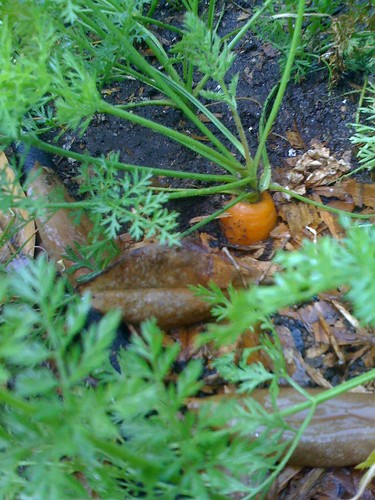
I have always struggled to get carrots, but this sucker is just one of many monsters growing in my plot. I ate this guy right after taking its picture. Very sweet. I am really excited. I will probably make a carrot soup out of this.
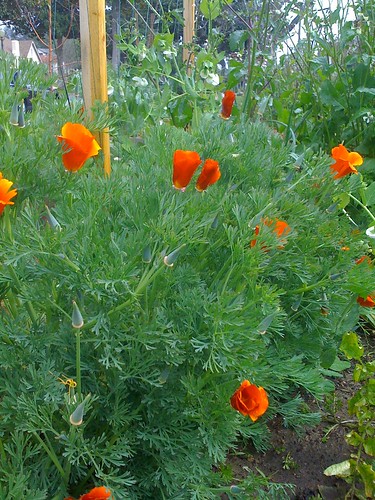
This was a poppy plant that grew from last years planting. It has very reddish-orange flowers. CA poppies are a great harbinger of spring around here. The reddish orange color just glows!

Something (probably pill bugs) is serious going after my potato plants. We'll just see how they do on their own. Good luck guys. I have too much Spring planting right now.

This is "rustic arugula" and is supposed to be similar to "wild arugula". The leaves are way different than standard arugula, much thinner and more "toothed". A tasting will be in short order and I am quite hopeful.

I have always struggled to get carrots, but this sucker is just one of many monsters growing in my plot. I ate this guy right after taking its picture. Very sweet. I am really excited. I will probably make a carrot soup out of this.

This was a poppy plant that grew from last years planting. It has very reddish-orange flowers. CA poppies are a great harbinger of spring around here. The reddish orange color just glows!

Something (probably pill bugs) is serious going after my potato plants. We'll just see how they do on their own. Good luck guys. I have too much Spring planting right now.

This is "rustic arugula" and is supposed to be similar to "wild arugula". The leaves are way different than standard arugula, much thinner and more "toothed". A tasting will be in short order and I am quite hopeful.
Tuesday, March 17, 2009
a really good tomato soup - an antidote to Alice Waters
I want to say, "THE BEST TOMATO SOUP EVAH!!", but it's probably not. It's not my recipe, but another recipe that I found on the tubes. This came via internetfoodassociation.com (great blog) which in turn came from ourkitchensinkrecipes.com. As I have said, I like things that are simple, and really flavorful. This one certainly is that. I think that the kicker is the spiciness in there. From start to finish, it took me thirty five minutes and that was with many interruptions due to kids, etc. Since this is the year of leeks, it is appropriate that this soup depends heavily on leeks for its flavor. I cannot wait to redo this recipe with fresh tomatoes instead of canned. Also, cheap is a major bonus of this recipe. Between the leeks, cream and canned tomatoes, it probably cost $7.50, and served a total of 5 meals.
from my kitchen:
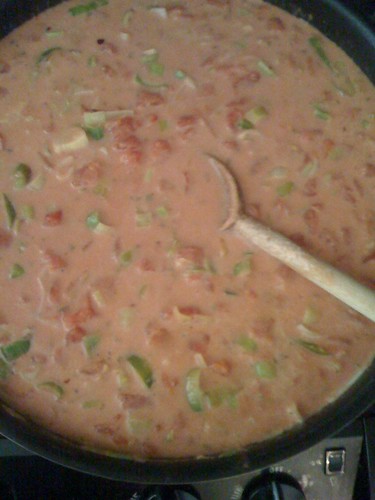
Note: it is not that creamy looking after blending it up. Also, I skipped the caramelized leeks for time and simplicity sake, but that is awfully good when you do it too!
Note again: I actually doubled the recipe, and froze half of it in 16 oz batches so that I made 3 lunches out of it.
So there you have it. This was really healthy, really simple, pretty quick, essentially organic, and quite cheap. I think that other than getting the recipe via a blog it also avoids the pretention factor as well.
from my kitchen:

Note: it is not that creamy looking after blending it up. Also, I skipped the caramelized leeks for time and simplicity sake, but that is awfully good when you do it too!
Note again: I actually doubled the recipe, and froze half of it in 16 oz batches so that I made 3 lunches out of it.
So there you have it. This was really healthy, really simple, pretty quick, essentially organic, and quite cheap. I think that other than getting the recipe via a blog it also avoids the pretention factor as well.
Creamy Tomato-Leek Soup
Adapted from Food & Wine
1 tablespoon unsalted butter
1 tablespoon, plus 2 teaspoons extra-virgin olive oil (divided)
3 leeks, divided (2 thinly sliced in half moons and 1 thinly sliced lengthwise)
3 garlic cloves, smashed
3 14-ounce cans whole tomatoes
1 cup water
1/2 cup heavy cream
1 tablespoon sugar
1/4 teaspoon crushed red pepper
1/4 teaspoon celery seed
1/4 teaspoon dried oregano
salt & pepper, to taste
In a large saucepan, melt the butter in the olive oil. Add the sliced half moons of leeks and smashed garlic and cook over moderate heat, stirring occasionally, until softened, about 5 minutes. Add the tomatoes and their juice, the water, heavy cream, sugar, crushed red pepper, celery seed and oregano and season with salt and pepper. Bring the soup to a boil over high heat, breaking up the tomatoes with the back of a spoon. Reduce the heat to moderate and simmer for 10 minutes.
Working in batches, transfer the tomato soup to a blender and puree until smooth.* Return the soup to a clean pot and rewarm the soup if necessary. Season the soup with salt and pepper.
In a small saucepan, heat the remaining two teaspoons of oil over moderate heat. Add the remaining sliced the leeks (the lengthwise ones) and cook, stirring every so often, until browned and crispy.
Divide the soup among six bowls and garnish with the crispy leeks.
Yield: 6 bowls
* As I said in the post, I used an immersion blender here. I think a food processor would work well too.
Alice Waters is Frustrating!!
Alice Waters, the founder of Chez Panisse, which is by most measures the most influential restaurant in terms of defining the fresh food cooking movement in our country, is so frustrating as a movement leader. Others have made this point here and here, but this video from CBS news interview with her is a PERFECT example. She is so right on that healthy food can be relatively inexpensive and quick to cook.

But she tries to demonstrate the point by going on National Television, cooking a "simple breakfast" for the reporter, and (at about 8:15 minutes into the webcast) cooks an egg in a HAND HAMMERED COPPER COOKING SPOON OVER A FIRE IN A HEARTH BUILT INTO HER KITCHEN. It couldn't look more absurd. IT COULDN'T LOOK MORE ABSURD!!!!!
Perhaps, dialing back her fantasy/obsession with rustic preparation, she could have simply fried that egg up with a little olive oil in a $10 pan over a stove. The meal would have tasted 97% as good, and would have been acessible to 99.9% more people who don't have fireplaces built into their kitchens and hand hammered copper cooking spoons.
changing policy on food will require both a cultural shift as well as policy shifts, that in turn rely on lots of people changing their minds about how we do things. Alice Waters has done an amazing job at pointing the way to better eating. She really needs to step back and not let herself become the face of the new food movement.

But she tries to demonstrate the point by going on National Television, cooking a "simple breakfast" for the reporter, and (at about 8:15 minutes into the webcast) cooks an egg in a HAND HAMMERED COPPER COOKING SPOON OVER A FIRE IN A HEARTH BUILT INTO HER KITCHEN. It couldn't look more absurd. IT COULDN'T LOOK MORE ABSURD!!!!!
Perhaps, dialing back her fantasy/obsession with rustic preparation, she could have simply fried that egg up with a little olive oil in a $10 pan over a stove. The meal would have tasted 97% as good, and would have been acessible to 99.9% more people who don't have fireplaces built into their kitchens and hand hammered copper cooking spoons.
changing policy on food will require both a cultural shift as well as policy shifts, that in turn rely on lots of people changing their minds about how we do things. Alice Waters has done an amazing job at pointing the way to better eating. She really needs to step back and not let herself become the face of the new food movement.
Saturday, March 14, 2009
on my bedside table...
and bathroom floor, and living room tables, and kitchen table. I think you get the point. At least of how my wife feels about the books that I take a shine to. The follow me around the house in no discernible order or timing, leaving the "impression" of messiness...
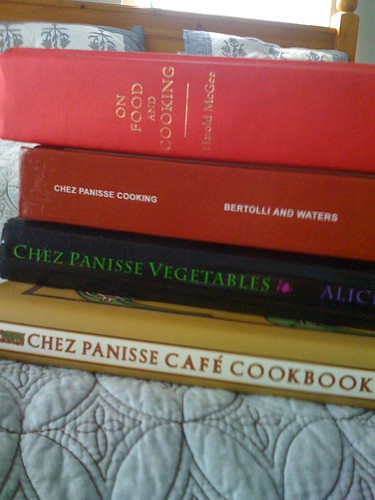
Anyway, I wanted to review four books that I received as Christmas presents. Thanks Mom! They are all good, but two of these stand out as somewhat essential for the home gardener/cook, those of us that fashion ourselves as cooking from a potager and like food with fresh taste.
On Food and Cooking
Chez Panisse Cooking - This was/is my favorite of the bunch. Kitchen gardeners will immediately be taken with this one, I think. It is a romantic yet (mostly) practical guide to cooking with ingredients that are as fresh as the ones we have to work with out of our garden. This book could have been written today and been well-regarded. That it was written 20 years ago is simply incredible and is a testament to how forward-looking Chez Panisse is. Paul Bertolli has a very accessible appreciation for simple, rustic flavors and a sophisticated understanding of the origins of ingredients. While many recipes would require too much work for most of us, there are many that are simple, but with the right ingredients are fantastic. I will be spending a lot of time this summer working my way through this one.
I want to write much more about this one, but suffice it to say, I will have more to say as I try out a number of recipes. I may be able to start soon with spinach soup as I have some spinach in the garden that tastes great, but does not look so presentable. Or possibly a double soup, spinach soup and carrot soup, paired in a bowl.

double soup
Chez Panisse Vegetables
Chez Panisse Cafe Cookbook
UPDATE: ARRRRGGH!!! just lost a lot of edits here. will update tomorrow. this is way undone!!! OOHHHH, I am MADDDDDDD!!!! I was Brilliant!!

Anyway, I wanted to review four books that I received as Christmas presents. Thanks Mom! They are all good, but two of these stand out as somewhat essential for the home gardener/cook, those of us that fashion ourselves as cooking from a potager and like food with fresh taste.
On Food and Cooking
Chez Panisse Cooking - This was/is my favorite of the bunch. Kitchen gardeners will immediately be taken with this one, I think. It is a romantic yet (mostly) practical guide to cooking with ingredients that are as fresh as the ones we have to work with out of our garden. This book could have been written today and been well-regarded. That it was written 20 years ago is simply incredible and is a testament to how forward-looking Chez Panisse is. Paul Bertolli has a very accessible appreciation for simple, rustic flavors and a sophisticated understanding of the origins of ingredients. While many recipes would require too much work for most of us, there are many that are simple, but with the right ingredients are fantastic. I will be spending a lot of time this summer working my way through this one.
I want to write much more about this one, but suffice it to say, I will have more to say as I try out a number of recipes. I may be able to start soon with spinach soup as I have some spinach in the garden that tastes great, but does not look so presentable. Or possibly a double soup, spinach soup and carrot soup, paired in a bowl.

double soup
Chez Panisse Vegetables
Chez Panisse Cafe Cookbook
UPDATE: ARRRRGGH!!! just lost a lot of edits here. will update tomorrow. this is way undone!!! OOHHHH, I am MADDDDDDD!!!! I was Brilliant!!
Thursday, March 12, 2009
Year of Leeks
This year, I am determined to get something going with leeks. I was inspired last year when I was helping my mother-in-law in Oregon plant her garden, and at her local nursery had these amazing flats of leeks with probably 100 little leeks in there for like $4. I have never seen anything like that in So. Cal. So I decided to start a flat myself.
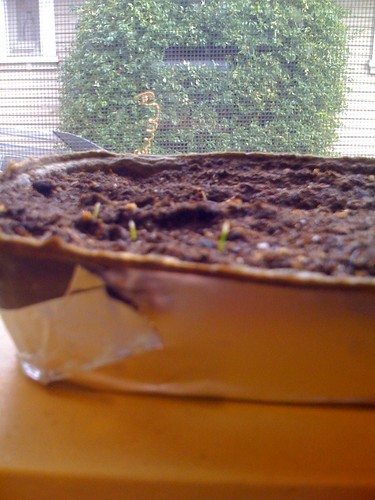
You can just barely see the leeks emerging in this pick and they are getting bigger now. We'll see how things go. But leeks are really good and really underutilized in American cooking, so I am setting about to change that. One Front Yard Garden at a time.
Fortunately, I just came across this post by David Lebovitz about the glories of leeks. with better pictures than mine. He does a great job describing why leeks are so good in cooking. i.e. more mellow onion flavor.

So, have at it. I am going for it with leeks this year, let me know if you have any good sources that I don't know about.

You can just barely see the leeks emerging in this pick and they are getting bigger now. We'll see how things go. But leeks are really good and really underutilized in American cooking, so I am setting about to change that. One Front Yard Garden at a time.
Fortunately, I just came across this post by David Lebovitz about the glories of leeks. with better pictures than mine. He does a great job describing why leeks are so good in cooking. i.e. more mellow onion flavor.

So, have at it. I am going for it with leeks this year, let me know if you have any good sources that I don't know about.
Wednesday, March 11, 2009
front yard right now
I want to wait until I get the perfect picture, but when does that happen? In the interest of not letting the perfect be the enemy of the good here is fyg, march 2009:
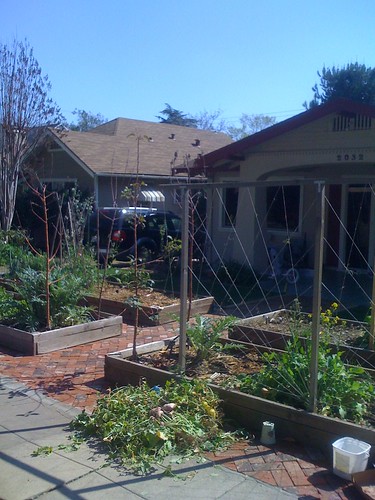
note the pile of old snap peas and bucket of bone meal in preparation for the tomato plants that just went in.

note the pile of old snap peas and bucket of bone meal in preparation for the tomato plants that just went in.
Tuesday, March 10, 2009
you think people are interested in this stuff, maybe?
interesting post by michael pollan at the NY Times "Well Blog", asking for "eating rules" that people have grown up with or come up with on their own. It's for his next project. But what is interesting is how many responses/comments he got on the post. 1,593!!! On one blog post. So I ask again, "you think people are a little bit interested in this stuff?"
greatest herb mix ever
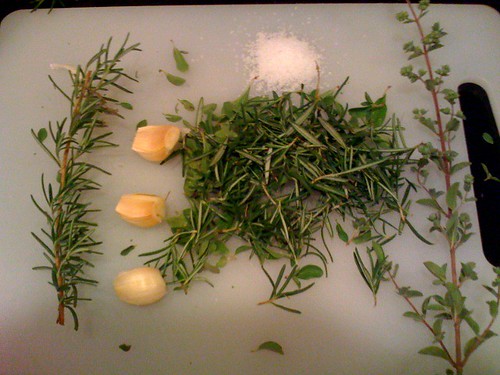
Thanks to David Liebowitz, I discovered the great use of meat rubs, that can be prepared, saved and used any time to provide a robust flavor to a variety of meats. I rarely get to save it because I usually make it right before preparing some large turkey which uses most of it up. I will discuss the preparation and use.
First, the preparation. As you can see in the picture above, you use a healthy amount of the following: rosemary, garlic, marjoram (or originally sage), and salt. I am being pretty vague, because frankly, as long as you are using lots of fresh herbs, the precise proportions are not too important. I will include David's instructions below. Chop all of these together and it looks like this:

at this point if you don't use it, spread it on a cookie sheet to let it dry. it will be dry in 24-48 hours. The smell is amazing!
As for use, it is pretty straightforward. Rub it on the meat. Cook the meat.
Ok, but if you really want to know why I love this rub so much, I will tell you how I use it on turkey, for which I have received some pretty rave reviews...
Blueberries Blossoms
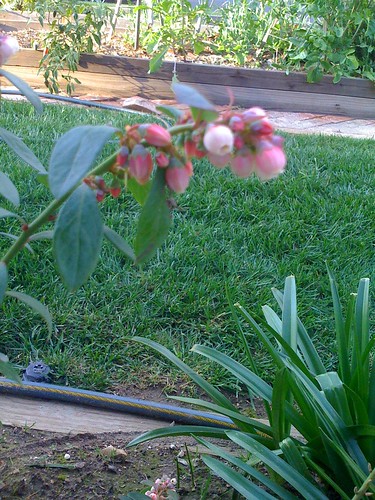
This year will be the first year that we have three blueberry bushes in full effect. They are currently loaded with blossoms that are turning into baby blueberries. I was amazed last year at how many blueberries a bush produces. I didn't measure it, but I expected a couple handfuls because my bushes were small. But each bush kept on producing handful after handful, which made me very, very happy. And they were good!
If you want to get inspired, this article is a good place to start. It is what inspired me. I am seeing blueberry bushes everywhere these days, so give them a try. If you live in Pasadena, there is a guy that sells great bushes at excellent prices at the Saturday Farmers Market.
Thursday, March 5, 2009
Interesting Food for Thought

I, like many, have wrestled with thoughts about how to take a really big agricultural system that produces tremendous amounts of cheap food and relies on lots of artificial inputs, and turn that into a sustainable, organic system that can produce the same goods at roughly the same cost, but without all the nasty inputs.
This article in Mother Jones is provocative and written by a strong critic of our industrialized system. The short version is that what if instead of having such a black and white divide between conventional/organic agriculture, we could have a system that gave incentives to farmers to reduce nasty inputs by 80%. Wouldn't that also be a more sustainable path. Also, perhaps 100% organic is not sustainable.
I think that he sells some organic solutions short, but it is an important topic.
Thursday, February 26, 2009
Tangerine
Tangerines are good.

I don't know if I ever mentioned that we have a tangerine tree. In terms of childhood memories, it stands equal with apricots to me. But when it comes to flavor, it takes a slight backseat. But in January, apricot isn't around, so it's all about the tangerine.
Getting the first ripe tangerine in late December/early January is pretty great. It is a wonderful feature that Citrus is ripe in the dead of winter (So. Cal. edition ~50-60 F). Michael Ruhlmann is right, citrus is a great example of the benefits of seasonal produce shopping.
We are blessed with a mature tangerine tree, so no waiting around here. When the fruit is ready, time to dive in. Sadly this variety is a bit "seedy", but I can't complain, because the flavor is spectacular.
Also, sadly, two of my kids are allergic to citrus. They get a rash on there face and *other problems*. so sad.

I don't know if I ever mentioned that we have a tangerine tree. In terms of childhood memories, it stands equal with apricots to me. But when it comes to flavor, it takes a slight backseat. But in January, apricot isn't around, so it's all about the tangerine.
Getting the first ripe tangerine in late December/early January is pretty great. It is a wonderful feature that Citrus is ripe in the dead of winter (So. Cal. edition ~50-60 F). Michael Ruhlmann is right, citrus is a great example of the benefits of seasonal produce shopping.
We are blessed with a mature tangerine tree, so no waiting around here. When the fruit is ready, time to dive in. Sadly this variety is a bit "seedy", but I can't complain, because the flavor is spectacular.
Also, sadly, two of my kids are allergic to citrus. They get a rash on there face and *other problems*. so sad.
Apricots - tipping point
I love apricots

I have blogged on this before. But I am posting about the blooming of the apricots this year because this is the third blooming that I have observed with this tree. The first was days after I planted it and I harvested 3 apricots. Last year, there were more, though my impatience prevented me from eating many (any?) truly, fully ripe apricots, as I only got ~10 apricots. This year there will be probably a couple/few dozen.
It is whelming at times to observe time pass. 2 years ago, I thought it would be so long until I had fruit from the itty, bitty tree. Now it still seems as though I planted the tree a few weeks ago.

I have blogged on this before. But I am posting about the blooming of the apricots this year because this is the third blooming that I have observed with this tree. The first was days after I planted it and I harvested 3 apricots. Last year, there were more, though my impatience prevented me from eating many (any?) truly, fully ripe apricots, as I only got ~10 apricots. This year there will be probably a couple/few dozen.
It is whelming at times to observe time pass. 2 years ago, I thought it would be so long until I had fruit from the itty, bitty tree. Now it still seems as though I planted the tree a few weeks ago.
Wednesday, February 25, 2009
food culture
[caption id="" align="alignleft" width="300" caption="making ricotta"] [/caption]
[/caption]
I am in love with areas in which a high value on excellent food is ingrained in the culture. In my limited exposure, the only places in America that typically come to mind are Berkeley/Bay Area, CA & Portland, OR as well as a general sense about various locations around the south that center around barbeque, also Colorado for beer. Brooklyn was definitely not on my mental map.
But this article in NY Times definitely indicate that this is what's going on. Makes me want to drop everything and go visit. But it intensifies my question, "what makes an area prone to developing de novo, a food culture?" Berkeley, Portland & Brooklyn seem to be good examples of places that did not start out with a general, and intense interest in all things artisan food, but they have developed them. What leads to that?
Thinking of those three cities, I think that some common criteria emerge:
1. nearness to local small-scale agriculture. (LA is out of the running in many ways here)
2. nearness to medium-large urban centers which provide the customers willing to spend $$. Perhaps it also provides a certain "creative class" of individuals likely to be caught up in the ideas and romance surrounding the pursuit of excellence in food.
3. accessibility of cheap living and working spaces allowing true believers in food to experiment on a small scale.(not as true of Berkeley, perhaps, now as it was when foodie movement was founded there)
4. Others? I am open to suggestions here.
Lastly, are there steps that a city/region can take to foster & incubate such a culture. Pasadena, I am coming after you!
 [/caption]
[/caption]I am in love with areas in which a high value on excellent food is ingrained in the culture. In my limited exposure, the only places in America that typically come to mind are Berkeley/Bay Area, CA & Portland, OR as well as a general sense about various locations around the south that center around barbeque, also Colorado for beer. Brooklyn was definitely not on my mental map.
But this article in NY Times definitely indicate that this is what's going on. Makes me want to drop everything and go visit. But it intensifies my question, "what makes an area prone to developing de novo, a food culture?" Berkeley, Portland & Brooklyn seem to be good examples of places that did not start out with a general, and intense interest in all things artisan food, but they have developed them. What leads to that?
Thinking of those three cities, I think that some common criteria emerge:
1. nearness to local small-scale agriculture. (LA is out of the running in many ways here)
2. nearness to medium-large urban centers which provide the customers willing to spend $$. Perhaps it also provides a certain "creative class" of individuals likely to be caught up in the ideas and romance surrounding the pursuit of excellence in food.
3. accessibility of cheap living and working spaces allowing true believers in food to experiment on a small scale.(not as true of Berkeley, perhaps, now as it was when foodie movement was founded there)
4. Others? I am open to suggestions here.
Lastly, are there steps that a city/region can take to foster & incubate such a culture. Pasadena, I am coming after you!
Monday, February 23, 2009
Weekend Gardening Update 23Feb2009
I was busy this weekends in many ways. FYG Child #2 turned 5 years old and had a high tea with her best friend, her big sister and her mom. The boy and I scooted out and watched the Tour de California! We got to see Lance Armstrong and some really exciting racing around Pasadena's Rose Bowl.
As for gardening, I was able to harvest a big fistful of turnips, which I had planned on growing primarily for their greens. I did use them once, and I have largely cracked the code on making Cracker-Barrel-good turnip greens, but time got away from me and I didn't harvest them like I should and now I have a patch of pretty mature turnips. Here they are with some carrots that I harvested as well:
As for gardening, I was able to harvest a big fistful of turnips, which I had planned on growing primarily for their greens. I did use them once, and I have largely cracked the code on making Cracker-Barrel-good turnip greens, but time got away from me and I didn't harvest them like I should and now I have a patch of pretty mature turnips. Here they are with some carrots that I harvested as well:
Wednesday, February 18, 2009
in defense of in defense of food

So the upshot of "in defense of food" is that nutrients are good for us, but we don't get much benefit from them when we divorce them from their original context, i.e. food. Lo and behold, a compilation of studies, just reported in the NY Times comes to precisely the same conclusion:
Wednesday, February 11, 2009
hopeful signs from Dept. of Agriculture
No, this isn't in the front of my yard, but it is an issue that affects millions of kids.
the school lunch program.
My best understanding is that, basically, it is a dumping ground for all the unhealthy commodities that our current agri-business model of farming produces, and schools make "food" out of it. It is pretty pathetic.
Tom Vilsack as Secretary of Agriculture, has been taken as a pretty dismaying sign about what direction food/agriculture policy is going to take. This interview makes me more hopeful
the school lunch program.
My best understanding is that, basically, it is a dumping ground for all the unhealthy commodities that our current agri-business model of farming produces, and schools make "food" out of it. It is pretty pathetic.
Tom Vilsack as Secretary of Agriculture, has been taken as a pretty dismaying sign about what direction food/agriculture policy is going to take. This interview makes me more hopeful
Tuesday, February 10, 2009
Michael Pollan - Again

Yeah, so I am a Pollan-phile, and I will have more to say about him, I am sure, particularly about his relatively new book, "In Defense of Food", soon, but if you haven't gotten to read or hear much from him, I present this interview with Bill Moyer. It gets to a lot of his issues and thinking. It can also be downloaded as a podcast, so you can listen at your leisure:
http://www.pbs.org/moyers/journal/11282008/watch.html
Tuesday, February 3, 2009
A Good Start
One of my goals as a parent is to continue the appreciation for basic cooking skills that I grew up with. Or more precisely, an expectation that the food I eat comes from a process called cooking, which more often than not, I carry out. With that in mind this picture of the FYG progeny #2, caught in a spontaneous, but intense, state of play-cooking is heart warming.
Sunday, January 25, 2009
Things I never knew were so good - arugula!
As a part of an ongoing series, I explore foods that I never would have eaten if not for a little patch of dirt to grow them in.
Arugula. This the veggie that I thought only some wacko liberal was supposed to like. But as is often the case I found myself with a packet of seeds and an inkling of interest in something new sparked by a friend's recommendation. So, I spread some seed for a cutting patch of greens and WOW with a simple vinagraite, or as recommended by a friend, lemon juice, good olive oil, salt and pepper, you are eating good!
Arugula. This the veggie that I thought only some wacko liberal was supposed to like. But as is often the case I found myself with a packet of seeds and an inkling of interest in something new sparked by a friend's recommendation. So, I spread some seed for a cutting patch of greens and WOW with a simple vinagraite, or as recommended by a friend, lemon juice, good olive oil, salt and pepper, you are eating good!
Tuesday, January 20, 2009
Oh my goodness
what a great day!
[caption id="" align="alignleft" width="450" caption="The New First Couple!!!!"] [/caption]
[/caption]
[caption id="" align="alignleft" width="450" caption="The New First Couple!!!!"]
 [/caption]
[/caption]
Wednesday, January 14, 2009
Baby lettuce salad
As I was thinning a bed of scattered romaine lettuce, it seemed a waste of all the baby lettuce leaves to throw them away so instead I composed a salad. Feeling adventurous and lazy, I forwent removing the roots opting instead to rinse very well. With a classic vinegraitte the result was excellent. The roots provided a bit of bite and heartiness. Additional fyg bonus: fresh garlic chives fir viniagrette.
Subscribe to:
Posts (Atom)




